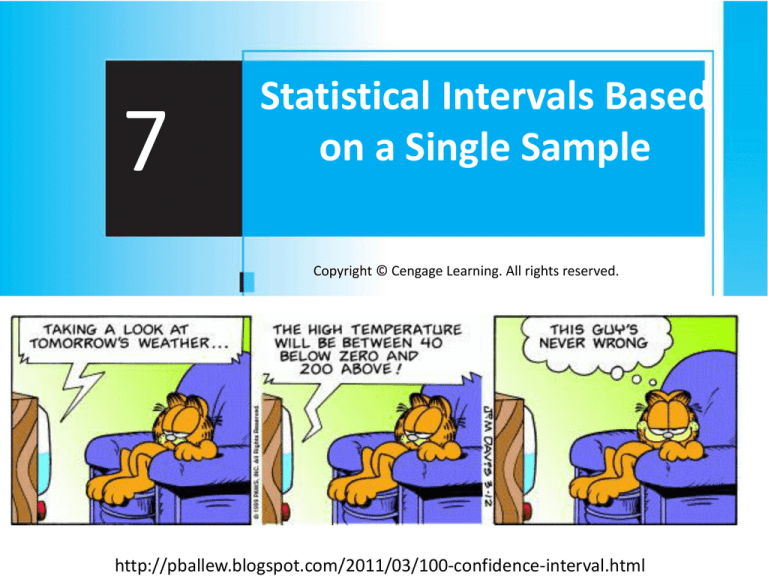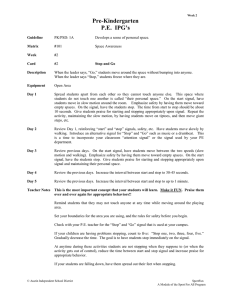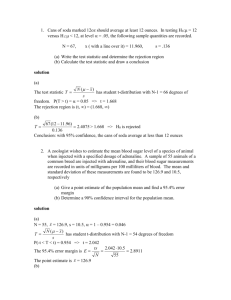
7
Statistical Intervals Based
on a Single Sample
Copyright © Cengage Learning. All rights reserved.
http://pballew.blogspot.com/2011/03/100-confidence-interval.html
Example 7.1: CI
Industrial engineers who specialize in ergonomics are
concerned with designing workspace and devices
operated by workers to achieve high productivity and
comfort. This is a report on a study of preferred height
of an experimental keyboard with large forearm-wrist
support. A sample of 31 trained typists was selected,
and the preferred keyboard height was determined for
each typist. The resulting sample average preferred
height was 80.0 cm.
Assuming that the preferred height is normally
distributed with = 2.0 cm, obtain a 95% CI for μ, the
true average preferred height for the population of all
experienced typists.
Interpretation
of CI
Other Levels of Confidence
P(–z/2 Z < z/2) = 1 –
Figure 7.4
Example 7.3*: CI
A production process for engine control housing
units of a particular type has recently been
modified. Prior to this modification, the data
suggested that the standard deviation of the
hole diameters was 0.100 mm. It is believed that
the modification did not change the standard
deviation, but the value of the mean diameter
may have changed. A sample of 40 housing units
is selected and the hole diameter is determined
for each one, resulting in a sample mean
diameter of 5.426 mm.
What is the 99% CI of the new hole diameter?
Example: Confidence Level & Precision
Assuming a normal population with unknown
mean μ and has a standard deviation σ = 2.0.
Using a sample size of 25, we obtain x̄ = 1.0
What are the 100%, 99%, 95%, 90% C.I. for μ.
Suppose that a sample size of 100 also yields
x̄ = 1.0. What is the 99% C.I?
Which of these intervals is the narrowest?
Example: Confidence Level & Precision
Assuming a normal population with unknown μ,
the 90% and 95% C.I.’s give (-0.30, 6.30) and
(-0.82, 6.82). Which one is the 95% C.I.?
Example 7.4: Calculating n
Extensive monitoring of a computer time-sharing
system has suggested that response time to a
particular editing command is normally
distributed with standard deviation of 25 msec.
A new operating system has been installed, and
we wish to estimate the true average respond
time μ for the new environment. Assuming that
the response time is still normally distributed
with σ = 25, what sample size is necessary to
ensure that the resulting 95% CI has a width of
(at most) 10?
CI for population proportion
𝑝 ± 𝑧𝛼
𝑝 ± 𝑧𝛼
2
𝑧
𝑝𝑞
𝛼 2
+ 2
𝑛
4𝑛
2
2
𝑧𝛼2 2
1+
𝑛
𝑝𝑞
𝑛
𝑧𝛼2 2
𝑝+
2𝑛
where 𝑝 =
𝑧𝛼2 2
1+
𝑛
Example: CI for proportions
Among 1000 cats in Indiana, 20% are found to
be long-hairs.
What is the 95% CI for the proportion of longhair cats in Indiana?
What sample size should be used if we want an
interval width of 0.01?
What sample size should be used if we want an
interval width of 0.01 if the proportion was
unknown?
CI: one-sided vs. two-sided
http://labs.geog.uvic.ca/geog226/frLab4.html
Shape of t-distribution
Definition of t critical value
Illustration of a t critical value
Figure 7.8
t-distribution
(text book)
Definition of t critical value
Illustration of a t critical value
Figure 7.8
Shape of t-distribution
Examples: t-table
a)
b)
c)
d)
Find t0.1,10
Find t0.005,30
Find t0.5,120
Determine the t critical value that will
capture the desired t curve when
i. the central area is 0.95, df = 16.
ii. lower tail area is 0.1, df = 16
e) For an r.v. T which follows a t distribution,
with df = n-1, what is P(-t/2,n-1 <T < t/2,n-1)?
X
Examples: t-table
-tα/2,n-1
tα/2,n-1
http://www.jurgott.org/linkage/util.htm
Example: One-Sample t CI
In a particular car, when the brake is applied at 62
mph, the following data give stopping distance (in
feet) for 10 random trials on a dry surface.
(http://www.nhtsa.dot.gov/cars/testing/brakds/b.pdf.)
146.9
147.5
148.4
147.5
149.4
149.3
148.6
148.4
150.3
145.5
a) Can we say that the data are approximately
normally distributed?
b) Find a 95% confidence interval for the population
mean stopping distance, μ
Example: One-Sample t CI (cont)
In a particular car, when the brake is applied at 62
mph, the following data give stopping distance (in
feet) for 10 random trials on a dry surface.
(http://www.nhtsa.dot.gov/cars/testing/brakds/b.pdf.)
a) Can we say that the data are approximately
normally distributed?
2
Normal Q-Q Plot
1
0
144
-1
-2
146
148
150
152
Example: One-Sample t CI
In a particular car, when the brake is applied at 62
mph, the following data give stopping distance (in
feet) for 10 random trials on a dry surface.
(http://www.nhtsa.dot.gov/cars/testing/brakds/b.pdf.)
146.9
147.5
148.4
147.5
149.4
149.3
148.6
148.4
150.3
145.5
a) Can we say that the data are approximately
normally distributed?
b) Find a 95% confidence interval for the population
mean stopping distance, μ
Example: One-Sample t CI – One side.
In a particular car, when the brake is applied at 62
mph, the following data give stopping distance (in
feet) for 10 random trials on a dry surface.
(http://www.nhtsa.dot.gov/cars/testing/brakds/b.pdf.)
146.9
147.5
148.4
147.5
149.4
149.3
148.6
148.4
150.3
145.5
c) Find a 95% confidence interval for the upper bound
of the population mean stopping distance, μ.
d) What sample size is necessary to ensure that the
resulting 95% CI has a width of (at most) 1.5 ft?



